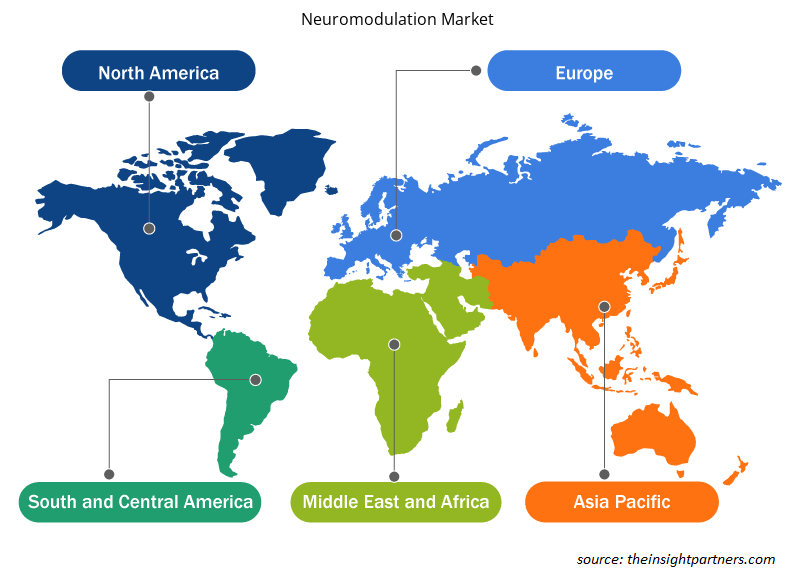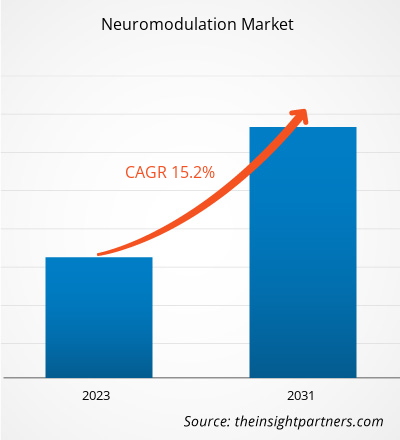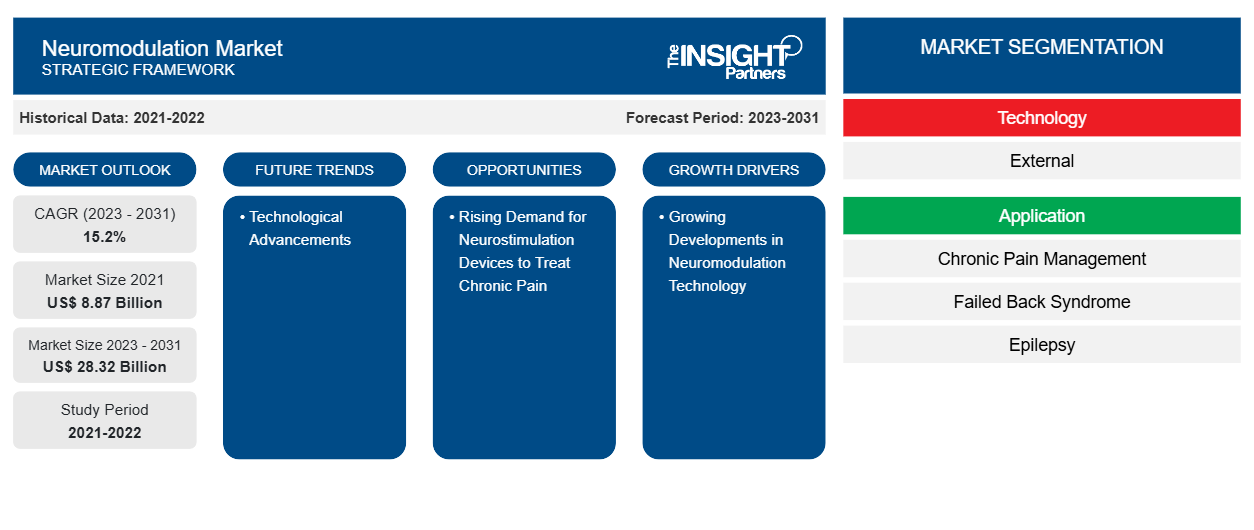神经调节市场规模预计在 2021 年为 88.7 亿美元,在 2023 年为 XX 亿美元,预计到 2031 年将达到 283.2 亿美元;预计 2023-2031 年的复合年增长率为 15.2%。神经系统疾病发病率的增加和神经调节技术的不断发展是驱动因素。技术进步可能仍将是神经调节市场的关键趋势。
神经调节市场分析
神经调节装置包含脊髓、大脑或周围神经上的小电极。脑血管病、帕金森病和阿尔茨海默病等神经系统疾病会影响身体的神经功能,因此可以通过神经调节来治愈。此外,医疗器械公司在神经调节方面的发展也日益增多,治疗神经系统疾病的培训项目也越来越多。例如,2023 年 12 月,全印度医学科学院神经调节高级研究与卓越中心为医疗专业人员推出了一项关于精神健康神经调节技术的培训项目。
神经调节市场概况
北美是神经调节的最大市场。增长主要由帕金森病、癫痫、阿尔茨海默病和抑郁症等神经系统疾病的发病率推动。例如,根据疾病预防控制中心的数据,阿尔茨海默病患者每 5 年增加一倍,达到 65 岁,到 2060 年,这一数字预计将增加两倍,达到 1400 万人。在所有族群中,与男性相比,女性患阿尔茨海默病的可能性几乎是男性的两倍。此外,在 65 岁及以上的美国人中,阿尔茨海默病仍然是第五大死亡原因,2000 年至 2019 年间,中风、心脏病和艾滋病毒导致的死亡人数增加了 145% 以上。
定制此报告以满足您的需求
您可以免费定制任何报告,包括本报告的部分内容、国家级分析、Excel 数据包,以及为初创企业和大学提供优惠和折扣
-
获取此报告的关键市场趋势。这个免费样品将包括数据分析,从市场趋势到估计和预测。
神经调节市场驱动因素和机遇
神经调节技术的不断发展
神经调节器通过精确地将电或药剂输送到目标部位来改变神经活动。这些被反复用于缓解慢性疼痛,不断发展的技术也增加了其应用范围。例如,2022 年 11 月,CVRx 推出了一种用于治疗心力衰竭的新型神经调节装置。这种神经调节装置可治疗心力衰竭的症状,即新型 Barostim NEO2 植入式脉冲发生器 (IPG)。第二代产品将 IPG 的尺寸缩小了 10%,并将电池寿命延长了 20%,从而减少了患者及其提供者的设备更换频率。此外,2021 年 4 月,美敦力宣布 FDA 批准进行一项试验性设备豁免 (IDE) 试验,以评估其内部开发的植入式胫骨神经调节 (TNM) 装置,该装置旨在缓解膀胱失禁症状。
用于治疗慢性疼痛的神经刺激设备需求不断增长——这是一个机遇
老年人和患有骨质疏松症、类风湿性关节炎等疾病的人对疼痛管理设备的需求日益增长。NCBI 研究表明,在印度,有近 6100 万人患有骨质疏松症,其中 80% 是女性。印度骨质疏松症的发病高峰比西方国家早 10-20 年。这些疾病需要神经刺激设备来治疗疼痛。
此外,一些初创公司正在设计以神经刺激疗法为主要重点的设备。在治疗过程中,这些设备向脊髓、背根神经节和大脑提供电刺激,帮助放松肌肉并减轻疼痛。因此,神经刺激疗法的优势促进了神经调节市场增强型产品的开发。
北美、欧洲和亚洲各国对神经调节设备的采用已显著增加。
神经调节市场报告细分分析
有助于得出神经调节市场分析的关键部分是技术、应用和分销渠道。
- 根据技术,神经调节市场分为外部(非侵入性)神经调节和内部神经调节。外部神经调节进一步细分为呼吸电刺激 (RES)、经皮神经电刺激 (TENS) 和经颅磁刺激 (TMS)。此外,内部神经调节部分还细分为深部脑刺激 (DBS)、骶神经刺激 (SNS)、胃电刺激 (GES)、脊髓刺激 (SCS) 和迷走神经刺激 (VNS)。内部神经调节部分在 2023 年占据了更大的市场份额。
- 根据应用,神经调节市场分为抑郁症、肌张力障碍、慢性疼痛管理、腰椎退化综合征、帕金森病、癫痫、震颤、失禁、胃轻瘫、强迫症 (OCD) 和偏头痛。慢性疼痛管理领域在 2023 年占据了更大的市场份额。
- 根据最终用户,神经调节市场分为医院、诊所和家庭医疗保健。医院部门在 2023 年占据了更大的市场份额。
神经调节市场份额(按地区)分析
神经调节市场报告的地理范围主要分为五个地区:北美、亚太、欧洲、中东和非洲、南美/南美和中美。
北美一直主导着神经调节市场。市场的增长归因于神经调节医疗器械领域的不断发展、人们神经系统疾病发病率的上升以及对用于慢性疼痛管理的神经调节设备的需求不断增加。此外,治疗神经系统疾病的经济负担在该国显著增加。预计亚太地区将在未来几年以最高的复合年增长率增长。
神经调节市场区域洞察
Insight Partners 的分析师已详细解释了预测期内影响神经调节市场的区域趋势和因素。本节还讨论了北美、欧洲、亚太地区、中东和非洲以及南美和中美洲的神经调节市场细分和地理位置。

- 获取神经调节市场的区域特定数据
神经调节市场报告范围
| 报告属性 | 细节 |
|---|---|
| 2021 年市场规模 | 88.7 亿美元 |
| 2031 年市场规模 | 283.2亿美元 |
| 全球复合年增长率(2023 - 2031) | 15.2% |
| 史料 | 2021-2022 |
| 预测期 | 2023-2031 |
| 涵盖的领域 |
按技术分类
|
| 覆盖地区和国家 |
北美
|
| 市场领导者和主要公司简介 |
|
神经调节市场参与者密度:了解其对业务动态的影响
神经调节市场正在快速增长,这得益于终端用户需求的不断增长,而这些需求又源于消费者偏好的不断变化、技术进步以及对产品优势的认识不断提高等因素。随着需求的增加,企业正在扩大其产品范围,进行创新以满足消费者的需求,并利用新兴趋势,从而进一步推动市场增长。
市场参与者密度是指在特定市场或行业内运营的企业或公司的分布情况。它表明在给定市场空间中,相对于其规模或总市场价值,有多少竞争对手(市场参与者)存在。
在神经调节市场运营的主要公司有:
- 雅培,
- 波士顿科学公司,
- 美敦力,
- NeuroPace 公司,
- NeuroSigma 公司
- NEVRO 公司
免责声明:上面列出的公司没有按照任何特定顺序排列。

- 获取神经调节市场顶级关键参与者概述
神经调节市场新闻和最新发展
神经调节市场通过收集来自一级和二级研究的定性和定量数据进行评估,其中包括重要的公司出版物、协会数据和数据库。以下是神经调节市场的发展列表:
- 美国食品药品管理局 (FDA) 批准雅培的 Eterna 脊髓刺激 (SCS) 系统用于治疗慢性疼痛。该设备可提供更好的体验,每年只需无线充电五次,与其他可充电 SCS 系统相比,充电负担最低。(来源:雅培/新闻稿,2022 年 12 月)
- GrayMatters Health 是一家开发数字自我神经调节疗法的心理健康护理公司,该公司宣布在美国推出用于治疗创伤后应激障碍 (PTSD) 的 Prism。用于治疗 PTSD 的 Prism 是首个获得美国食品药品监督管理局 (FDA) 批准作为 PTSD 标准护理 (SOC) 处方辅助手段的自我神经调节设备,目前在美国有 2 家诊所提供该设备。(来源:GrayMatters Health,新闻稿,2024 年 1 月)
神经调节市场报告覆盖范围和交付成果
“神经调节市场规模和预测(2021-2031)”报告对以下领域进行了详细的市场分析:
- 范围内所有主要细分市场的全球、区域和国家层面的市场规模和预测
- 市场动态,如驱动因素、限制因素和关键机遇
- 未来主要趋势
- 详细的 PEST/波特五力分析和 SWOT 分析
- 全球和区域市场分析涵盖关键市场趋势、主要参与者、法规和最新市场发展
- 行业格局和竞争分析,涵盖市场集中度、热点图分析、知名参与者和最新发展
- 详细的公司简介
- 历史分析(2 年)、基准年、预测(7 年)及复合年增长率
- PEST和SWOT分析
- 市场规模、价值/数量 - 全球、区域、国家
- 行业和竞争格局
- Excel 数据集
近期报告
客户评价
购买理由
- 明智的决策
- 了解市场动态
- 竞争分析
- 客户洞察
- 市场预测
- 风险规避
- 战略规划
- 投资论证
- 识别新兴市场
- 优化营销策略
- 提升运营效率
- 顺应监管趋势























 获取免费样品 - 神经调节市场
获取免费样品 - 神经调节市场